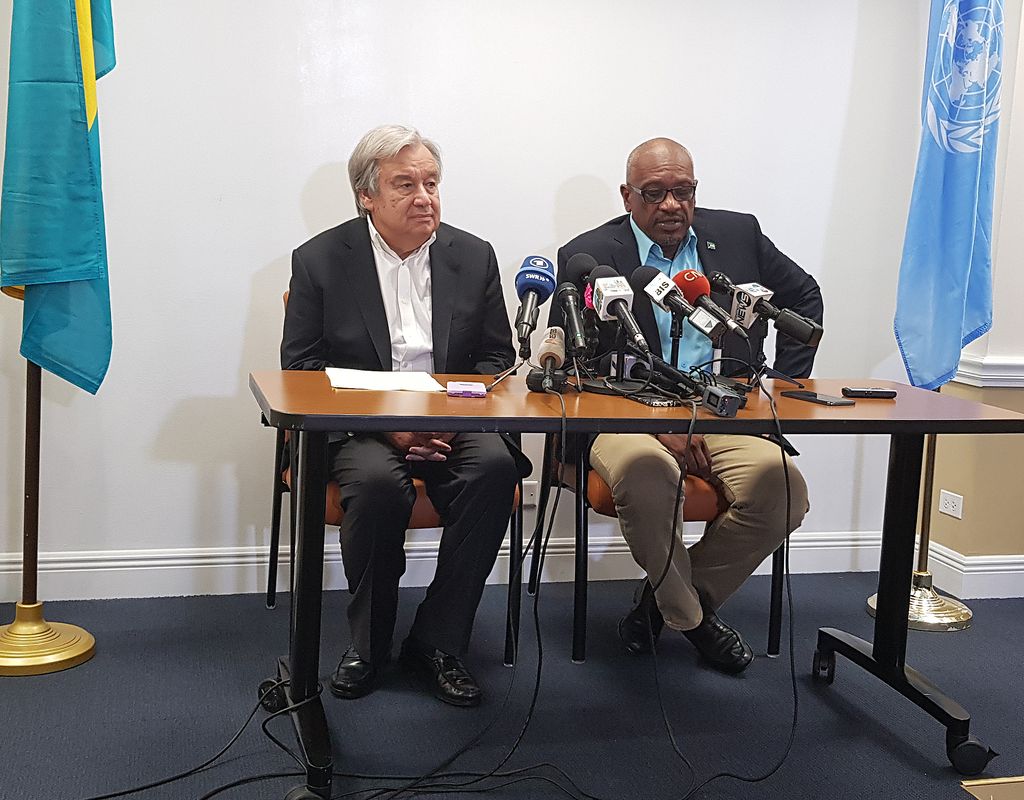|
UN Secretary General Antonio Guterres said the world is in a climate crisis and steps must be taken by all world leaders including those in the Caribbean to mitigate the effects of global warming and climate change.
Guterres, spoke at a media conference yesterday, at the office of Prime Minister's Dr Hubert Minnis in The Bahamas after arriving for a two day visit on the island. He first met with the Bahamian Prime Minister to discuss the devastating impact of Hurricane Dorian that assaulted The Grand Bahama Islands and the Abaco islands almost two weeks ago. "The financial cost of the damage caused by Dorian is not clear, but it will be in the billions of dollars.The Bahamas cannot be expected to foot this bill alone.These new large scale climate-related disasters demand a new multilateral response," Guterres said. Sending a strong message to World and Caribbean leaders Guterres said, "Climate financing is on element.We must reach the target of $100billion dollars per year from public and private sources, for mitigation and adaptation in the developing world, as rich countries have been promising for nearly a decade." Making reference to the Bahamas, he said, "In cases like yours I strongly support proposals to convert debt into investment in resilience. Concessional financing must be made available to highly-indebted middle-income countries that are vulnerable to extreme weather events. But most importantly, the entire international community must address the climate crisis through raising ambition and action to implement the Paris Agreement." Guterres said this was extremely important as he painted a grim picture over the next ten years, if climate change was not taken seriously. "We are in a battle for our lives.But it is a battle we can and must win." The UN Secretary General said his heart went out to the people of The Bahamas and pledged relief and other assistance. Prime Minister Minnis said they did all they could have from the very first day the hurricane hit the islands. He said that despite the fact that they were facing a major obstacle trying to find accommodation for several thousands he was certain that over a period of time the problem would be solved. PM Minnis said the Bahamas was still economically sound and its "major financial hub of Nassau was unaffected an still open for business." Source: The Guardian, September 14, 2019
0 Comments
Greedy butchers have been identified by Agriculture Minister Clarence Rambharat as being a key reason for the continuing trade of illegal livestock and wild meat from Venezuela. The T&T Coast Guard intercepted a vessel just south of Icacos with two male Venezuelan nationals on board, 42 goats, 1 sheep and 12 bottles of alcohol on Sunday night.
In a Facebook post, Rambharat commended the law enforcement officers as well as the ministry’s staff saying vets and other animal health personnel were involved in the action which included the eventual destruction of the animals due to public and animal health concerns. “Venezuela has been red-flagged as a potential source of Foot and Mouth disease, a major threat to livestock,” Rambharat stated.He said over the past few years, there has been an upsurge in the illegal entry of livestock and wild meat from Venezuela. “Despite the best efforts to stop the trade, it is being encouraged by greedy butchers looking for a cheap source of meat.”He said the livestock which are brought in illegally usually show signs of disease.“We have warned consumers about buying from vendors who may be purchasing from unscrupulous butchers or who may themselves be buying or importing animals illegally.” Foot-and-mouth disease (FMD) is a highly contagious virus disease and is one of the most serious livestock diseases. It affects cloven-hoofed animals (those with divided hoofs), including cattle, buffalo, camels, sheep, goats, deer and pigs.Symptoms include fever, blisters in the mouth and on feet, drop in milk production, weight loss, and loss of appetite, quivering lips and frothing of mouth. Source: Newsday TT, September 2019. HAVING lived through years of darkness because of cataracts, two 70-year-old grandmothers could not stop smiling and offering thanks after chosen for surgery by a medical team on the USNS Comfort, a US Navy hospital ship. The ship is anchored near the Brighton Port at La Brea. Today a team of doctors will begin to prepare grandmother of five Jemina George of Biche. George smiled as she waited to the board the vessel. “To me, this is like a dream come true. I am so happy to be chosen and I am excited about being able to see.” George told Newsday. She said she had given up hope of having her vision restored. “I think what these people are doing is so nice, and may God continue to bless them. They have made me a happy woman. This is one of the best gifts I have ever received.” Point Fortin grandmother Shirley Best felt the same. When Newsday boarded the ship, Best was being taken to the surgical area for her second operation. “I feel great. I had a cataract removed from my right eye here and now I am going to remove the cataract from my left eye.” Best said she was grateful to the doctors and happy to be selected. “I can’t wait to return home to see my children and begin to see properly,” she said. Media personnel were given a tour of the hospital ship and invited into the operating theatre to witness Best's second cataract operation. The ship's tour captain Charles Cather said in 1987 the ship, a former oil tanker, was converted into a hospital for disaster relief and humanitarian work. He said the crew was happy to assist citizens and migrants. Audrianna Chastain, medical assistant chats with Point Fortin resident Shirley Best who had two Cataract surgeries done onboard the USNS Comfort medical ship, docked off the port of Brighton, La Brea. Photo by Lincoln Holder “We are here to help when health care systems start to get overrun with higher volumes of patients than expected. We are happy to be here.”
Trinidad-born US Navy sailor Mitchell Julien said it has been nine months since he joined the navy and he has already been to several countries. But even though the visit was brief he was excited to be in TT to visit his family. The 20-year-old Julien, from Arima, encouraged other young men to remain positive despite any challenges they may face. “Work hard and do what you have to do. Stay focused and you can make it.” The Comfort's medical team was expected to treat about 100 patients a day for the next five days. The international medical professionals on board are expected to provide a wide range of surgery, dental screening and treatment, optometry screening and eyewear distribution, among other services. The ship is anchored three miles off the port and the mission also has medical clinics on land at different venues, including the National Energy Skills Centre at La Brea and Funsplash at Debe. Source: Newsday, Sept. 6, 2019 Four million people have fled Venezuela, as the country continues to face economic and political crisis.
40,000 have gone to the small Caribbean islands of Trinidad and Tobago, just seven miles off the coast. But life isn’t easy for those who arrive, and some locals have made it clear they’re not welcome. The BBC’s Ashley John-Baptiste went to find out more. In 2018 - more than 35,000 people were forced to flee their homes every day - that's one every two seconds. This story is part of a BBC News series, called "The Displaced" - a selection of stories exploring the human impact of this movement, and how it is changing our world. Check back next week, Monday 23rd September, for our next episode in Uganda #TheDisplaced If you have been affected by these issues in Trinidad or anywhere else in the world and would like to speak to the BBC, email [email protected] AS TOLD TO BC PIRES
My name is Gary Griffith and I am a St Mary’s/Sandhurst old boy and I’m using all the traits I acquired at those two institutions to try to make TT a better country. I spent most of my life as an only child in the very boring Valsayn Park, but I (often) ran away to my grandmother’s massive family in Diego Martin to enjoy things that, unfortunately, many people don’t experience in Trinidad now. Doors were left open and children could walk free.You could go up the hill, pick mangoes, climb over the mountain, come back in the afternoon. Boat-racing in the canal. Now, young persons, inclusive of my son, have to spend their time behind locked doors and in front of some screen. I really didn’t need to become commissioner of police. Both my parents died back-to-back about three months before I became (the United National Congress) national security minister. And they both did pretty well, so I inherited quite a bit. They were divorced for 25-odd years so it looks like they couldn’t live with each other but, apparently, couldn’t live without each other either. My father was an old QRC boy and a true Trini. He loved everyone and everybody loved him. My mother was rigid, meticulous, stringent.I take character traits from both. One day, round the Savannah – I was about 14 – I asked a sno-cone man if he had a valid food badge. I never get cussed so in my life! I realised that day I mustn’t use all the traits of my parents! This country is full of negativity. In England, if Newcastle is being demoted from the Premiership, there will be 80,000 people in the stands for their last game. In TT, as soon as we feel we may not qualify, nobody turns up. That is how we are. Everyone who’s tried to do something for this country – the Brian Laras, the Stern Johns, the Russel Latapys, the Dwight Yorkes, Minshall, Rudder – they’re recognised as role models internationally – but they’re ridiculed at home. The national U-15 football team – little boys just trying to play football – and the country tried to destroy and undermine them. You can criticise it but you must stand firm with your country. Who has more problems now than the United States or the United Kingdom? But how many of them attack their own country? In Africa, all over the world – but, in this country, we attack our own. You may not have voted for a prime minister but he or she still represents YOU! The more you ridicule the prime minister, the more you undermine your own country! I’ve noticed that the people who know very little about any topic are the ones who speak the most. I want to tell people: have faith! Believe! Trust! When it comes to the main problem, crime, people feel the easiest thing to do is to blame the politicians, blame the police. But when you do that, you’re attacking your own. We are not the enemy. Trying to demonise us is not helping. Maybe it’s my military training but I work towards a chain of command of my God, my country and the citizens. If BC Pires tells me that people say I like to pose with guns for pictures, I ask, “Who wants death threats?” I don’t need to advertise. If people say, “Gary Griffith loves the camera,” it shows (their own) ignorance. I am just doing what is required. I see individuals who do that as hypocritical. I don’t go to the media, the media comes to me. So, because of me being accessible, you try to condemn me for it? I have stepped on many toes. There have been 27 death threats on me and my family from criminal elements in my first year as police commissioner. Before me, there wasn’t any death threat on any commissioner probably for years. So it means I’m doing something right. I’ll be turning the screws even harder. So I expect twice as many next year. In total contrast to what people may think, I have the world of respect for (businessman and social activist)] Kirk Waithe, who has attacked me for (what he apparently worries might be the militarisation of the police force). I think he has the interests of the country at heart and is just trying to make sure that checks and balances are in place. Kirk Waithe could be an asset towards my intention to clean up this country. My Sandhurst comrade Raffique Shah has attacked me. But at least I’m using my military training to try to help the country, not to overthrow it. The camouflage matter was blown totally out of proportion. Another unit used camouflage for 22 years. I’m not saying that makes it right, but there was a precedent. One point three million people did not see it as an issue. The five persons who did had access to the media and continued to pump it. In hindsight, if it hurt those five people so much – and one of those people is BC Pires – I could have held it back for a month. I have no problem with people who criticise me in a classy manner. But social media has provided (People’s National Movement) red and (UNC) yellow sycophants with an avenue. People try to call me a puppet – but this puppet stood firm against (the) government (in which he was a Cabinet minister) against (the programme associated with alleged corruption) Life Sport. That probably caused him to get fired. This puppet said state contracts shouldn’t be given to gangs. This puppet was bold enough to clear (controversial parliamentary revelations by now Prime Minister Keith Rowley) E-mailgate and (controversial accusations against then Prime Minister Kamla Persad-Bissessar) Plant-like-substance-gate. So who am I a puppet to? Well, I am a puppet – but to my God. People want change, they want the country to become better – but it mustn’t affect them personally. Don’t come and tell me I can’t drive intoxicated. Why you picking on us? Is because we are the One Per Cent! Why you only arresting us? Is because we are the little black boys! Go after everybody else but don’t harass me, my people, my race, my community. Gangs aren’t even involved in robberies much any more, because they’re getting easy money from the State. If you have two pothounds – and I refer to gang members as pothounds – in fact, I take that back: pothounds are very nice animals – if you give two pothounds two plates of food, they’re good. But if you take away one plate of food, they start attacking one another in the cage! So be it! The majority – almost 90 per cent – of our homicides involve people engaged in questionable activity. As much as the lady in the towel cries, “He was a good boy, police too wicked!” I called gang leaders, “cockroaches” and people were upset, so I wish to apologise: gang leaders are not cockroaches. Because cockroaches will get into your food, but they do not deliberately try to harm you. A gang leader is worse than a cockroach. So I wish to apologise…to the cockroaches! I might lose some fans with this statement, but I have NEVER eaten doubles in my life. One day I’ll try to understand why 20 people would stand up in front a wooden box on Sunday morning with curried channa running down their mouth because they just have to eat two more. I just don’t get it. A Trini is a citizen of the greatest country in the world. Simple as that. What TT means to me is this: I plan to live for my country. But I am prepared to die for it.[PHOTOs BY MARK LYNDERSAY] Source: Newsday TT, August 26, 2019 Prime Minister Dr Keith Rowley has announced that Trinidad and Tobago will assist the Bahamas with soldiers, electricity workers and US$500,000.
The prime minister made the announcement at Thursday's post-Cabinet news conference. Parts of the Bahamas have been decimated by Hurricane Dorian which hit the islands as a powerful Category 5 hurricane, resulting in at least 20 deaths. Dr Rowley told the media that he has been in touch with the prime minister of the Bahamas, Dr Hurbert Minnis and that they have discussed what Trinidad and Tobago could do for the Caribbean Community (Caricom) country. He said 100 members of the Defence Force are now preparing to go to the Bahamas to assist in law and order. With large swaths of the country without electricity, seven technical personnel of the Trinidad and Tobago Electricity Commission (T&TEC) are also being sent to the Bahamas. The prime minister said that the number will be increased once needed. While noting that the Bahamas is receiving "considerable assistance from US and Canada", he said Trinidad and Tobago will also provide monetary assistance to the tune of US$500,000 to assist in paying for some expenses, including medical supplies. Two CARICOM leaders touched down in the Bahamas Thursday morning to hold talks about relief efforts. Barbados Prime Minister Mia Mottley and St Lucian Prime Minister Allen Chastanet arrived at the Lynden Pindling International Airport in Nassau shortly before 9 am. According to Mottley's Facebook page, they were greeted by several Bahamian government ministers, including Minister of Tourism Dionsio D'Aguliar, Minister of Education Jeffery Lloyd and Minister of Transport Renwood Wills among other dignitaries. Both prime ministers were accompanied by CARICOM Secretary-General Irwin La Roque and were later whisked away for a closed-door meeting with Minnis at the National Emergency Management Administration (NEMA) office. The first large relief ship arrived in the northwest Bahamas on Thursday morning, with tugboats ferrying pallets of water bottles, boxes of cereal and 10,000 hot and cold meals from a Royal Caribbean cruise ship to battered Freeport. But with the grim toll still mounting, it was clear a lot more help will be needed for the once lush Grand Bahama and the neighbouring Abaco Islands. Source: Guardian, September 10, 2019  A production team from National Geographic Travellers was left stunned by the wide diversity of the ecosystems in Tobago. During their final day of filming, last Friday, in phase two of a marketing initiative by the Tobago Tourism Agency Ltd (TTAL), the production team expressed amazement that a small island like Tobago housed up to 240 species of birds, 640 species of plants and 160 tree species. They also appreciated how easily accessible the island's ecosystems, popular attractions and historical sites are for locals and visitors. Newsday was told the team, which left on Friday, visited the Argyle, Parlatuvier, and Castara waterfalls. This was the National Geographic's second visit to Tobago. In May, the team began filming a number of popular historical sites along the eastern end of Tobago. The team along with TTAL CEO Louis Lewis, on Thursday, also visited the oldest protected forest reserve in the Western Hemisphere, Tobago's Main Ridge Forest Reserve. Local tour guide William Trim, who assisted the production team, told Newsday, "When we went to the rainforest, we were able to get some lovely birds, both at the rainforest and at the waterfall, and seven to nine other species." Trim said this is not the first time Tobago's ecosystem has been featured globally and he believes this additional exposure will help sell the the island to nature lovers. "It was quite a privilege to be a part of marketing the product. Seems to me National Geographic will be able to push Tobago's beautiful scenery. I am happy TTAL has teamed up with them." National Geographic Travellers was invited by the TTAL as a marketing initiative to highlight Tobago's culture, people, sites, food and popular attractions. During the first phase of the production, several locals were interviewed. The team also captured aerial and underwater footage of some historical and pristine sites. This final content will be featured on National Geographic Traveller's website, their print and digital platforms. TTAL CEO Louis Lewis said this move is strategic in the rebranding of "Destination Tobago." He added, "Tobago, it is integral to create content aligned with our core pillars that illustrate Tobago as the unspoilt, untouched and undiscovered Caribbean island, where one can explore the extraordinary. "We are excited to partner with such an iconic publication with a stellar reputation in travel and tourism, and we look forward to the resulting content that we can share with the rest of the world. Source: Newsday, July 30, 2019  Dr. Alexandra Amon - THE MICHAEL PENSTON THESIS PRIZE 2018 The Michael Penston Thesis Prize 2018 has been awarded to Dr. Alexandra Amon for the thesis entitled ‘‘Cosmology with the Kilo-Degree Lensing Survey.’ Alexandra Amon completed her undergraduate and Ph.D. at the University of Edinburgh with Prof. Catherine Heymans and Prof. Chris Blake, after growing up on the islands of Trinidad and Tobago. Since then, she is a Kavli Fellow at Stanford University/SLAC, USA, as part of Prof. Risa Wechsler’s group. There she spends her time working as part of the Dark Energy Survey’s weak lensing team. WOW!!! This branded cab in London was part of Tobago Tourism's Tobago Beyond campaign. The Tobago Tourism Agency Limited’s destination marketing campaign, “Tobago Beyond”, has been shortlisted in the International Travel & Tourism Awards 2019 in the “Best National Tourism Board Campaign” and “Best Destination Campaign” categories.
A release from TTAL said the International Travel and Tourism Awards is presented by the World Travel Market and supported by the United Nations World Tourism Organisation. The awards are a global platform that recognises and promotes excellence within the travel and tourism industry. The 2019 Awards Ceremony will take place on Tuesday, November 5 in London, England. According to the release, the “Best National Tourism Board Campaign” award recognises which destination showcased its vibrancy, culture, and individuality through a consumer or trade campaign that leaves the viewer pushing the destination to the top of their bucket list, or wanting to return. The award for “Best Destination Campaign” looks at which destination’s campaign achieved volume and value growth in addition to encouraging visitation. TTAL said the submitted campaigns were assessed using tangible metrics, including proof of audience engagement, budget, and obstacles and how they were resolved. According to Nicole Smart, International Travel and Tourism Awards Organiser: “Our judges have been greatly impressed by the exceptional quality of entries, and those who are on the shortlist know they have reached a very high standard – they will be among the best in the world.” Tobago’s submission, “Revitalising Tobago Tourism”, outlined the aim of the “Tobago Beyond” campaign, which is to revitalise the international appeal of Tobago as a real challenger holiday destination for those seeking a Caribbean holiday. With limited resources in comparison to other Caribbean destinations, focusing on specific markets and traveler segments was a key part of the strategy. TTAL said the submission also indicated that all of the campaign’s KPIs (Key Performance Indicators) have outperformed, and resulted in double-digit growth of arrivals in 8 months, with the last three months showing 22 percent, 29 percent and 40 percent growth respectively. Commenting on the announcement of Tobago being shortlisted in the awards, Secretary for Tourism, Culture and Transportation, Councillor Nadine Stewart-Phillips said: “This accomplishment is another reflection of our continued commitment to advance the island's tourism sector. This is certainly a testament to the fact that we are going in the right direction with respect to greater visibility for destination Tobago. "Since the launch, the ‘Tobago Beyond’ campaign has attracted tremendous local and international interest and has yielded substantial results. I am heartened that our efforts are being recognised globally and look forward to the continued positive returns this recognition will bring.” Louis Lewis, CEO of the Tobago Tourism Agency Limited, also expressed his satisfaction with the news, stating: “We are honoured to be shortlisted for not just one, but two categories in these prestigious awards, due to the beyond ordinary marketing efforts of the Tobago Tourism Agency. Our intention has always been to enable Tobago to be a stand out destination in its own right using the island’s unique character and features to guide our creative and messaging exploration, and our recognition in these awards signify that our brand message is being received loud and clear.” Source: Newsday, August 2019 |
T&T news blogThe intent of this blog is to bring some news from home and other fun items. If you enjoy what you read, please leave us a comment.. Archives
June 2025
Categories
All
|







 RSS Feed
RSS Feed